Today’s item for the day is the critical skill of perseverance. Simply stated, the ability to keep going, long after you wished you had stopped. We continued to move gravel from the trench today, ..., all day. I was one of the loader – dumpers. We made significant progress, but there will be more tomorrow. I am still amazed by the people that still lend a hand. Lead scientists, college professors, standing next to high school students, discussing the events of the day as bucket after bucket gets filled.
The work of the last two days is in stark contrast to the excitement of Friday. Archaeology is like that, you go from remarkable discovery to grunt labor. That’s the way it goes sometimes, you can avoid the hard work for a little while but it still needs to get done eventually.
Before I get into the history of the Point and the area, a question or two have been raised about the "top-secret” artifacts and why they need to be top-secret. Some of the findings this summer have not been seen before, they are unique pieces that will revise the way scientists look at this area. The findings are "top-secret” because the journal or magazine that these discoveries will be written up in demand first access to the story and the pictures. In other words, the magazine insists that the story and images goes to them first, kind of like exclusive rights. So, I will keep you posted about the magazine and the timetable for publishing the story. Once the story is "out”, I will be free to explain more.
History of the Nuvuk People and Pt. Barrow The area we are working in is named both Nuvuk and Pt. Barrow. Nuvuk came first so I will stay with that term most of the time. Nuvuk also refers to the people who lived in the area, similar to referring to people from Scotland as Scots.
The Inupiat people have lived in this region for well over 1,000 years. They chose this place because of the large marine mammals that frequent this biologically rich area, where the Chukchi Sea meets the Beaufort Sea. Food, fuel, and building materials all come from the sea.
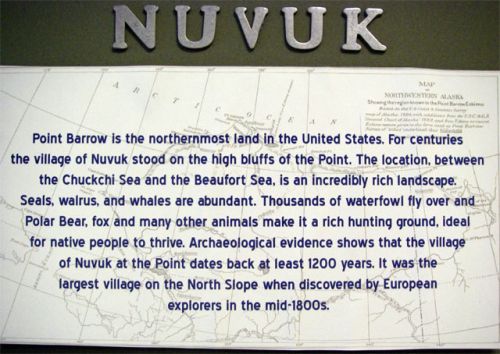 The history of Pt. Barrow or Nuvuk is an ongoing story. Each year more information as added as house sites, burial mounds, middens, and other materials are found. Again, it is like a puzzle, the more information we have the more pieces of the puzzle we have to work with.
The history of Pt. Barrow or Nuvuk is an ongoing story. Each year more information as added as house sites, burial mounds, middens, and other materials are found. Again, it is like a puzzle, the more information we have the more pieces of the puzzle we have to work with.
The food coming from the sea includes whale, seal, walrus, polar bear, and salmon. Today, native people still practice subsistence living. In other words, they hunt to survive. Look back at the cost of food items in the store, everything is significantly more expensive up here. Many jobs are seasonal at best, so families depend on the food they get from hunting to keep them fed during the summer as well as during the long winter.
The fuel for the native people was oil from either seal or whales. The oil was extracted and then burned for both light and heat. Here’s a picture from the Inupiat Heritage Center showing a woman burning seal oil. Keep in mind, that people were still doing that into in mid 1900’s.
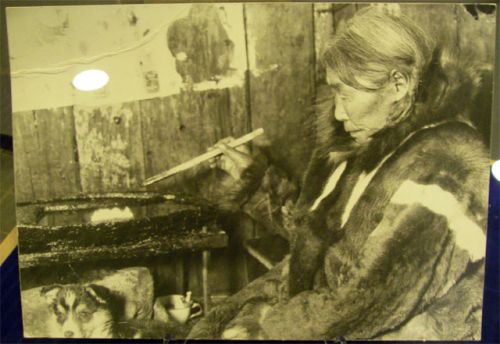 The fuel available for the native people of this area was seal oil. Look closely at this picture, you can see a small flame in the middle of the bowl. The seal oil was used for both heating as well as light.
The fuel available for the native people of this area was seal oil. Look closely at this picture, you can see a small flame in the middle of the bowl. The seal oil was used for both heating as well as light.
The building materials people used were whale bones and driftwood. They were found materials that would then be covered with sod, an underground passage would lead to the outside. A majority of the house was underground for insulation purposes. The house pictured below is probably from the early 1900’s. It’s a sod house, and whale bones frame the front entryway.
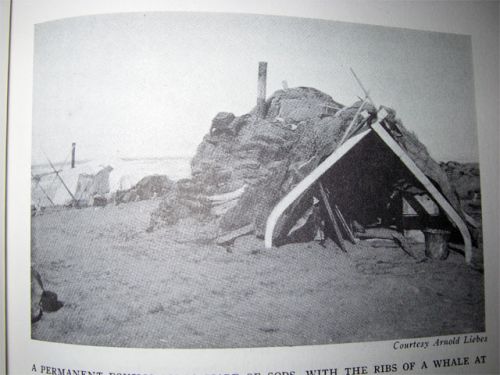 This image, from "Fifty Years Below Zero" by Charles D. Brower gives an indication of the houses that the natives built with local materials.
This image, from "Fifty Years Below Zero" by Charles D. Brower gives an indication of the houses that the natives built with local materials.
The landforms of the Point have changed over the years. Here is a series of paintings diagramming the change in the coastline.
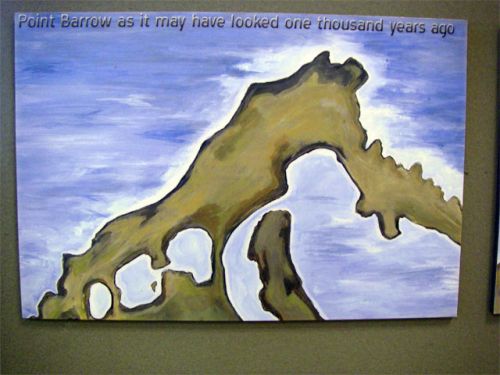 Coastlines inevitably move, we all remember the feeling of a wave drawing the sand out from around our feet. Here in Barrow, and in particular out at the Point, the changing coastline is exposing burials, houses, and artifacts that are very old.
Coastlines inevitably move, we all remember the feeling of a wave drawing the sand out from around our feet. Here in Barrow, and in particular out at the Point, the changing coastline is exposing burials, houses, and artifacts that are very old.
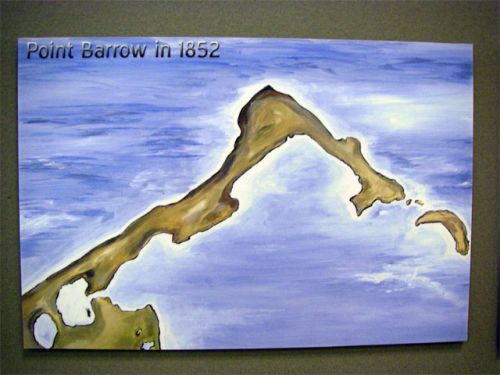 The coastline continues to move and change. Specific reasons why are difficult to determine.
The coastline continues to move and change. Specific reasons why are difficult to determine.
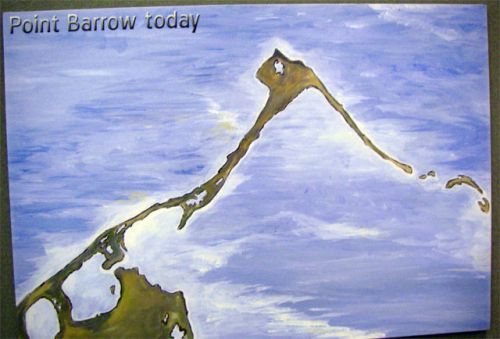 Looking at the three paintings, as well as the words of Capt. Maguire, one can easily understand why it is important for us to stay up late, and work super-hard to get as much done as possible this season. The beach and coast are continually moving, the changing pattern of sea ice is probably making matters worse.
Looking at the three paintings, as well as the words of Capt. Maguire, one can easily understand why it is important for us to stay up late, and work super-hard to get as much done as possible this season. The beach and coast are continually moving, the changing pattern of sea ice is probably making matters worse.
And so we dig, in a hurry. The specific materials we are uncovering are parts of houses, scraps of driftwood, remnants of fires, animal bones, pieces of worked bone, and much more. Here’s a little sample of what I saw at the Inupiat Heritage Center.
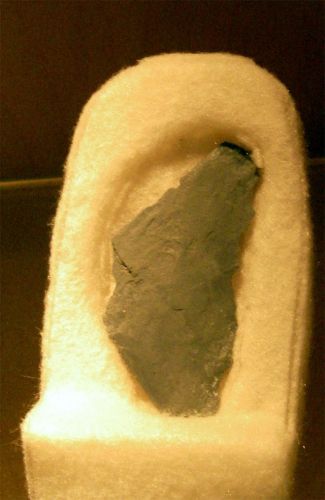 We have found pieces of rock material that are very similar to this piece here. Native people would flake off the slate or perhaps chert to make a sharp edge that could be used for hunting or cutting. This piece is about 4 cm long, I found one about 3 cm long!!
We have found pieces of rock material that are very similar to this piece here. Native people would flake off the slate or perhaps chert to make a sharp edge that could be used for hunting or cutting. This piece is about 4 cm long, I found one about 3 cm long!!
I will make a point to get in the lab and shoot some pictures of objects we have seen in the last few weeks. I will also do a whole journal on animal bones. I think tomorrow is only a half a day of shoveling so there will be more good stories emerging from this adventure. Stay tuned for more journals and pictures!!

